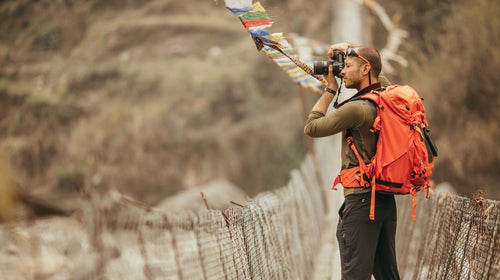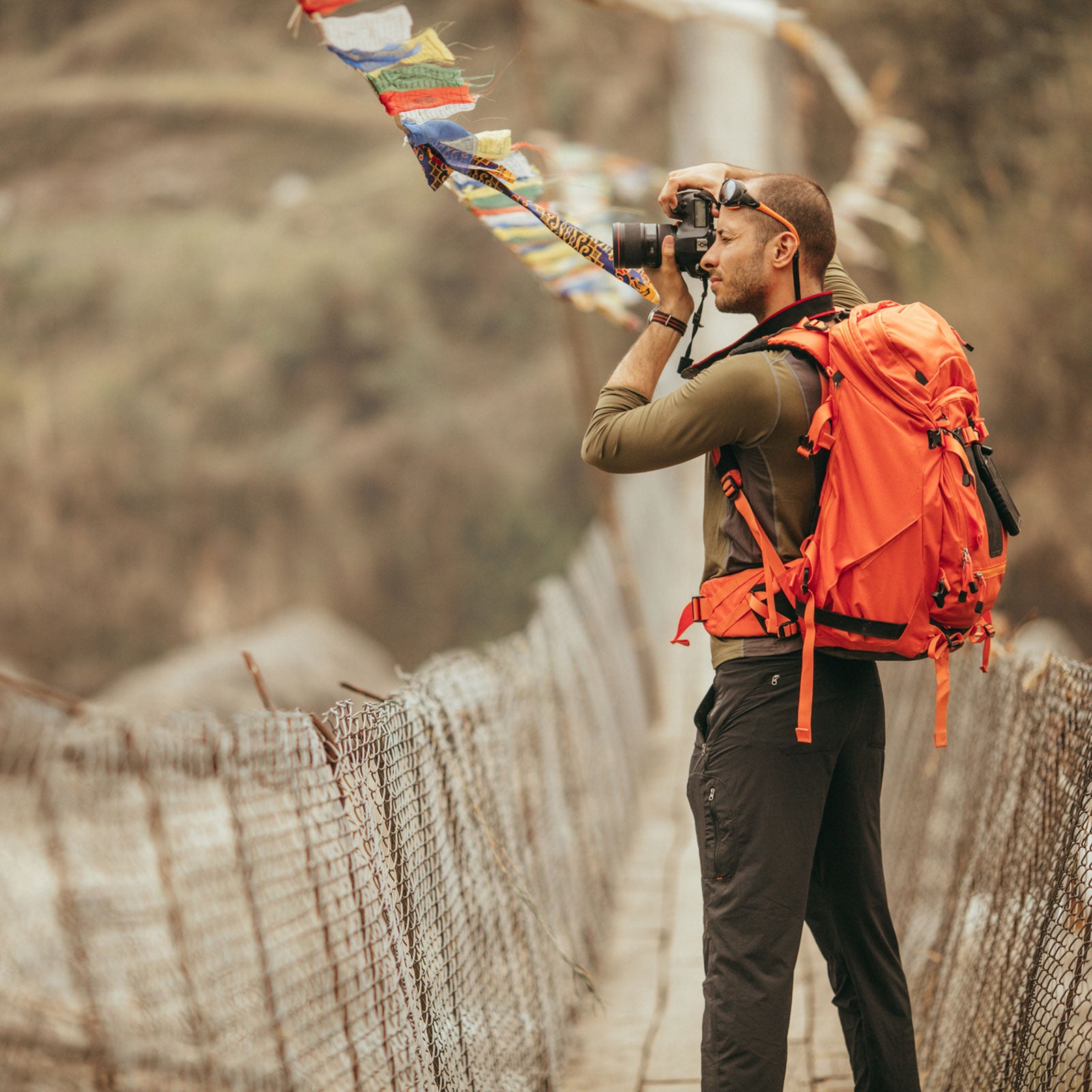Smartphones are a great tool for documenting your adventures. But it's╠řimpossible╠řto make your pictures stand out among╠řthe╠řthrongs╠řof iPhone-wielding tourists all vying for the same shot. (Case in point:╠ř alone is has 486,000 tags╠řon Instagram.)
In the end, thereÔÇÖs only so much you can do with a phone. To really improve your╠řphotography and videography skillsÔÇöeither to make the leap to pro work or simply grow your social media followingÔÇöyouÔÇÖll need to invest in a proper kit. Thanks to todayÔÇÖs technology, this no longer means lugging╠řthousands of dollars worth of gear. A basic starter camera, paired with solid capture and editing skills, will go a long way toward adding a professional polish to your portfolio.╠ř
Buying your first camera setup can be overwhelming, and in my years as a professional photographer and videographer, I've developed a sense for what gear is worth your hard-earned cash.╠řHere is a comprehensive guide of what you needÔÇöand everything you donÔÇÖtÔÇöfor╠řyour beginner kit.╠ř
Learning Tools
A new, fancy camera is useless without the skills to go with it. One of the best things I did for my career was take a black and white film photography class in college, which forced me to leave auto mode behind and learn how aperture, shutter speed, ISO, and lens choice all affect the outcome of a photo. Going full manual on an old film camera forces you to focus on framing and light, and makes you a more thoughtful photographer since youÔÇÖre limited to 36 frames instead of an almost bottomless memory card.╠ř Buy a ╠ř($179), a , and look for a class at your local community college, photography store, or check╠řonline╠řresources like , where you can learn the foundations of film for $29.╠ř
If you want to stick to digital photography or are interested in videography, take an online course through . At $20 per month for a subscription (your first month is free) theyÔÇÖre affordable and offer a wealth of knowledge on everything from gear choice to advanced post-production techniques. If youÔÇÖre starting off with a GoPro, the on their app is an easy way to begin to learn editing. It automatically turns your clips into a cohesive story, while allowing you to customize things like music, coloring, and length.╠ř
Camera Body
With how advanced todayÔÇÖs smartphones are, a point-and-shoot is no longer much of an upgrade. Interchangeable lens cameras, on the other hand, have larger sensors that let in more light, giving you far better image quality and control over depth of field (for example, when your subject is in focus but the background is blurred out) than a phone or basic digital camera.╠ř╠ř
There are two big considerations to make when buying a camera╠řbody: crop sensor versus full frame, and a digital single-lens reflex camera (DSLR) versus mirrorless.
The sensor is the part of the camera that captures and converts light, turning what's in your viewfinder╠řinto a digital image.╠řWhile many cameras will tout their megapixels (the number of individual light units that make up an image)╠řas a measure of╠řquality, megapixels╠řdonÔÇÖt matter as much as sensor size, since with a smaller sensor the pixels can't capture as much light. Still, look for a body with between 16 to 20 megapixels for a clearer, less grainy outcome.╠ř
A full frame camera will have a larger sensor than a crop, and will therefore give you advantages like better low-light performance. However, there is really no need to invest in one as a beginner.╠řTheir crop cousins are less expensive and still capable of taking high-quality photos. Plus, crop sensors are close in size to what comes standard on many digital cinema cameras, making them perfect for video. Keep in mind, though, that a crop sensor will act as a focal╠řÔÇťÔÇŁ, essentially giving you a more zoomed-in shot than╠řa full frame with╠řthe same lens. This means that a 75 millimeter lens on a full-frame camera will act more like a 50 millimeter lens on a crop (more on lenses below).
When debating mirrorless versus DSLR, go with the former. As it's╠řname suggests, mirrorless cameras ditch the reflective glass in DSLRs that bounces light back onto an optical viewfinder. Instead, mirrorless cameras╠řallow light to pass directly onto the camera's sensor and into a digital viewfinder or screen. There is plenty of out╠řthere about the differences between the two models, but the main advantage of a mirrorless body is that they can be made smaller and lighter without sacrificing quality, which is a superior choice╠řwhen you're on the move.╠ř
SonyÔÇÖs crop sensor line of mirrorless cameras offers╠řa lot of the same╠řbenefits of its full-frame siblings like the A7Sii or A7Rii, such as great auto focus, outstanding low-light capability, and impressive video codecs, but at╠řa lower price point. You can find a body for less than $700, or opt for the ╠ř($1000)╠řif you have more to spend. IÔÇÖve used an a6300 as my travel camera for a few years now╠řand absolutely love it. ItÔÇÖs lightweight and produces a fantastic image, plus it╠řshoots gorgeous 4K videoÔÇögood enough that I often use it as a second camera on commercial╠řshoots. If youÔÇÖre looking for one body that can shoot video and stills equally well while still being highly portable, the a6300 is it.╠ř
Though╠řimage quality should be your top priority when choosing a camera, there are a couple other factors to consider. A durable, weather-sealed body, while not necessary in a starter setup, is great for shooting in varying conditions when on the road. WiFi capability is an added bonus for travel, which allows you to quickly share photos of your trip to Instagram without having to transfer them to your computer then back to your phone.╠ř
│ó▒▓ď▓§▒▓§╠ř
Many people never take off the lens that came attached to their camera when they bought it. This can work as a start, but youÔÇÖll get much better results by investing in some decent glass. The rule of thumb is that youÔÇÖre better off spending your money on lenses than a camera body, as itÔÇÖll make a far bigger difference in image quality. If you're buying your body new, save some cash by skipping the kit lens and instead purchase one or two nicer ones after the fact.╠ř
Since lenses are usually specific to brand,╠řitÔÇÖs important to consider which one you plan to stick with for the long run before you invest in good glass. That said, with Sony's E-Mount,╠řyou can buy adapters for just about any lens out there,╠řwhich is another reason I recommend going the a6300 route.
Another major consideration is whether you want a zoom or a prime lens. Zooms allow you to adjust the focal length while primes are fixed and force you to zoom by moving toward and away from your subject, but often have a wider aperture range and are typically sharper (not to mention cheaper).╠ř
What to look for in a lens all depends on what type of photography and videography you plan to do. Sticking with my a6300 example from above, here are a few to consider:
For zoom lenses, F4 ($600)╠řis a great all-rounder with a nice focal range that will allow you to shoot everything from desert landscapes to friend portraits. If you want to shoot more wide-angle nature shots, the Milky Way, or often find yourself in low-light situations (like slot canyons in Utah), ╠ř($450)╠řis a great option.╠ř
Personally, though, I think buying one or more 35 or 50 millimeter prime lenses, like , ($450)╠řis the way to go. Sure, youÔÇÖll have to get some exercise to zoom in or out, but you'll be able to produce a stronger image and have something more fitted for travel, as they're generally lighter and more portable.
Accessories
Packing
You can always wrap your camera in some clothes and shove it in your suitcase. But if you're investing in new gear, it pays to pack it right so it doesnÔÇÖt get destroyed by careless baggage handlers or bumpy back roads. are cheap and do a decent job, but a dedicated camera pack is a better buy. A good one will be able to serve as an all-around travel backpack, with enough room for snacks and extra layers along with╠řprotective compartments for your body and lenses.╠ř
╠ř($120)╠řis a great option because the durable nylon exterior fabric helps to keep things dry, and the inner, removable camera pod ensures your body and lenses are well protected. Plus, it's side access allows you to get╠řyour camera out fast when the perfect shot presents itself.╠ř
Tripods
Full tripods are unwieldy and hard to travel with. The , ($50)╠řon the other hand, is highly portable, with bendable legs that allow you to attach it to just about anything for more height.╠ř╠ř
For video, go with a gimbal.╠ř╠řIt gives you a huge boost in quality over a tripod, allowing you to capture smooth, cinematic shots that will up the production value of your footage more than any other piece of your kit. ╠ř($439)╠řis made for small, mirrorless cameras, and adds a selfie mode thatÔÇÖs great for vlogging.╠ř
Vloggers should also consider a small attachable microphone, like ╠ř($60).╠řNothing ruins a video faster than bad audio, and this one captures far better sound than a cameraÔÇÖs built-in mic.╠ř
Post Production
With photography and videography, shooting is only half the battle. The real hard work comes once you get home and have to figure out what to do with the hours of footage and thousands of photos on your hard drive. AdobeÔÇÖs Creative Cloud Photography Plan starts at just $10 per month and gives you both Photoshop and Lightroom, the only two tools you need as a beginner. Lightroom allows you to organize your photos and make quick edits to things like color balance and clarity, a great primer before diving into Photoshop's╠řmore advanced features.╠ř
For video editing, Mac users would be wise to start out with iMovie. ItÔÇÖs free, intuitive, and plenty powerful for a beginner just interested in making quick vlog edits. For PC or more advanced filmmaking, you can always tack on Premiere Pro to your Adobe subscription╠řfor $20 per month. Again, LinkedIn learning has classes in using each of these editing tools.╠ř


